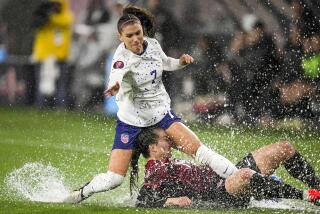Cayard, Davis Are Matchless in Semifinals : Sailing: Il Moro di Venezia to meet New Zealand in today’s championship.
SAN DIEGO — When New Zealand crewman Dean Phipps went up the mast, observers wondered if he was looking for migrating whales or trying to locate Nippon Challenge, the distant rival in Friday’s semifinals of the International America’s Cup Class World Championship.
Actually, the Kiwis had a rigging problem they had to fix, allowing Chris Dickson to make up 6 1/2 minutes and provide the only moment approaching excitement in the first match-racing tests of the new IACC boats.
Once confident that the mast wouldn’t fall, Rod Davis steered the New Zealand boat to a comfortable 2-minute, 9.4-second victory--a photo finish compared to the other semifinal.
Paul Cayard blew away Il Moro di Venezia sparring partner John Kolius literally by a mile in three laps around the new 22.6-mile America’s Cup course.
Dennis Conner wasn’t there to see it--he was in New York hustling sponsors--but he predicted it.
Borrrrr-ing .
Even Tom Ehman, the executive director of the America’s Cup Organizing Committee, joked at an afternoon preview of clips from the upcoming movie “Wind,” filmed in windy Fremantle, Australia with 12-meters, “Too bad we didn’t have some racing like that today.”
The winds were a light 7-10 knots, with a deep swell--typical conditions off San Diego--and Dickson said that “made the racing boring not only for (observers) but for us.”
Kolius said. “We started keeping an eye on the Kiwis (in the next race), hoping they wouldn’t pass us.”
At least the boats should be more evenly matched today, when Davis and Cayard will meet for the title Conner eschewed at 1:15 p.m., 15 minutes after Dickson and Kolius start the consolation race.
ESPN will telecast events live, starting at 1. Stand by with some of those clips from Fremantle in ’87.
When the new boats were conceived, Conner reasoned with flawless logic that faster boats would not mean more exciting races but more lopsided races because, he said, “One boat is usually going to be faster than another,” and any speed differentials would be magnified at greater speeds.
Better to stick with the old, sluggish 12-meters, he said. The races would be slower but closer. San Diego Yacht Club Commodore Sandy Purdon, a racing sailor, agrees with Conner.
“These boats are a little too lively for match racing,” Purdon said Friday. “They certainly are very exciting for fleet racing, but as we saw today they need to prove to us, in my opinion, that they’re the right boat for an America’s Cup match race.”
Their one redeeming virtue is that they’re so fragile. Even when a boat is far ahead, its rival need not give up hope. The mast might fall down.
New Zealand had a lead of 7:25.9 rounding the next-to-last mark when, co-skipper David Barnes said, “We heard a loud bang.”
The portside titanium chainplate--it anchors the rigging supporting the mast from that side of the boat--had fractured. The crew collected every available line on the boat and sent Phipps up to the second spreaders--about a third of the way up the 106 1/2-foot mast--to reinforce the rig with emergency shrouds.
All those days learning how to tie sailor’s knots really paid off. Davis held onto a lead of 1:07.1 around the last mark, then doubled it downwind to the finish.
“We nursed the boat as well as we could,” Barnes said. “We debated as to whether we could carry a headsail on port tack.”
They figured they had 16 minutes before reaching the port layline, when they would have to tack or sail farther than they had to to fetch the windward mark. Phipps finished just in time.
Then they all held their breath and tacked.
Davis said, “If we’d felt there was a chance the rig was gonna come down, we would have retired. If Chris had passed us, we would have retired.”
And: “If we’d been racing Dennis today, we wouldn’t have won. He wouldn’t have been that far behind, if he would have been behind at all.”
Dickson conceded that his boat was not in the Kiwis’ class Friday. Especially with a heavier mast to replace the one it lost last week, it needs stronger wind to get up to speed.
So Dickson knew he needed to do something early to have a chance. A minute before the start he protested Davis for luffing him illegally. If guilty, Davis would have had to do a 270-degree penalty turn after the start, but the on-the-water umpires--another new wrinkle in the Cup--waved off the incident with a green flag.
Then Dickson, desperate for a good start, had his boat over the line at the gun, had to circle back to re-start and never had a chance.
“My error,” he said. “I misjudged it.”
In the other match, Cayard jammed his teammate behind the committee boat and sailed away at the gun as Kolius struggled to get up to speed.
Neither Kolius nor Dickson attempted tactical comebacks by tacking away on fhe first windward leg, and after that they were so far behind it didn’t matter.
“On our boat,” Dickson said, “we were actually keeping tabs on Kolius.”
More to Read
Go beyond the scoreboard
Get the latest on L.A.'s teams in the daily Sports Report newsletter.
You may occasionally receive promotional content from the Los Angeles Times.










